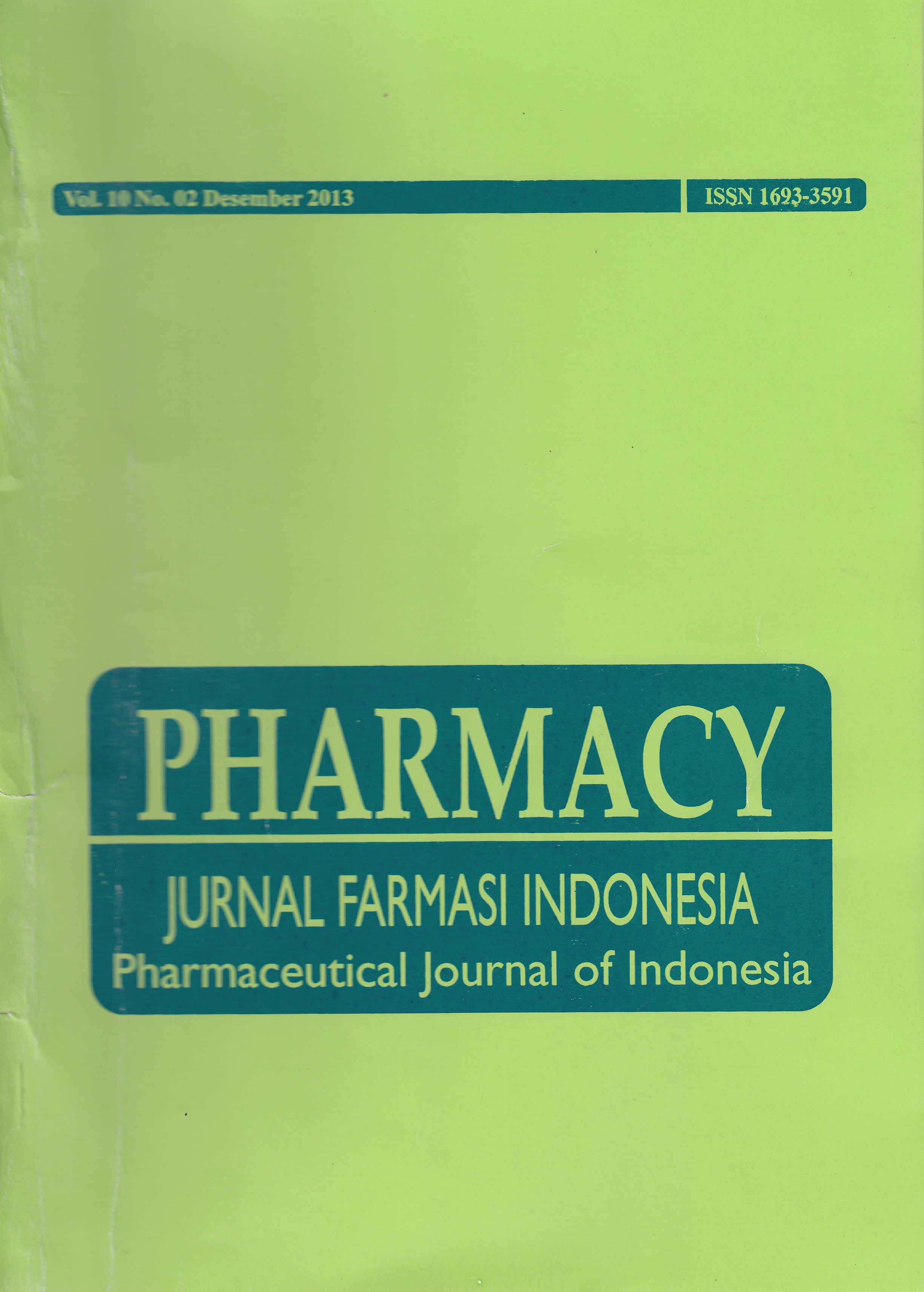EFEK REPELAN KOMBINASI MINYAK ATSIRI RIMPANG TEMULAWAK (Curcuma xanthorrhiza Roxb. Rhizome) DAN RIMPANG JAHE (Zingiber officinale Roxb. Rhizome ) DALAM BASIS UNGUENTUM LENIENS TERHADAP NYAMUK Aedes aegypti
DOI:
https://doi.org/10.30595/pji.v10i2.803Abstract
ABSTRAK Kasus demam berdarah yang tinggi mengharuskan masyarakat untuk berusaha mengendalikan laju penyebaran virus dengue dengan menghindari atau mengurangi kontak dan gigitan dengan nyamuk. Dalam usaha mencari bahan alam yang mempunyai efek repelan, telah dilakukan uji efek repelan kombinasi minyak atsiri rimpang temulawak dan rimpang jahe terhadap nyamuk Aedes aegypti. Rimpang temulawak dan rimpang jahe diisolasi minyak atsirinya dengan menggunakan metode destilasi uap dan air. Bahan uji dibuat dalam berbagai konsentrasi 2% v/b, 5% v/b, 10% v/b, 15% v/b, 20% v/b, dan 25% v/b. Kontrol positif digunakan adalah repelan DEET 12,5% dan kontrol negatif digunakan basis unguentum leniens. Metode yang digunakan adalah metode “Comparative Efficacy of Insect Repellent against Mosquito Bites” yang telah dimodifikasi. Efek repelan dianalisis dari waktu penolakan yaitu waktu pertama kali nyamuk menggigit. Hasil percobaan diperoleh bahwa semakin besar konsentrasi minyak atsiri dalam repelan maka semakin besar waktu penolakan nyamuk Aedes aegypti. Repelan dengan konsentrasi 25% v/b (konsentrasi terbesar) merupakan sediaan yang paling baik dan memenuhi persyaratan sebagai repelan karena mempunyai waktu penolakan yang paling lama. Kata kunci : minyak atsiri, Aedes aegypti, unguentum leniens, repelan ABSTRACT The highes of the dengue fever cases make the society have to control the spread of the dengue virus with avoid and decrease contact and mosquito bite. In find the natural resource that has repellant effect, have been done repellant research effect with volatile oil combines from Curcuma xanthorrhiza rhizome and Zingiber officinale rhizome to Aedes aegypti. Volatile oil of Curcuma xanthorrhiza rhizome and Zingiber officinale rhizome were isolated using steam and water destilation method. The test composition made with different concentration, that are 2% v/b, 5% v/b, 10% v/b, 15% v/b, 20% v/b, and 25% v/b. The positive control is repellant DEET 12,5% and the negative control is unguentum leniens base. The method of this test is “Comparative Efficacy of Insect Repellent against Mosquito Bites” which modified. Repellant effect analyzed from refusal time, that is mosquito’s bite in the first time. The research result is higher concentration of volatile oil followed by increasing of refusal time on Aedes aegypti. Repelant with 25% v/b concentration (the biggest concentration) were the best preparation and good in standard as repellent. It caused that concentration had longest refusal time. Key word: volatile oil, Aedes aegypti, unguentum leniens, repellantReferences
Ardiana, D, 2005, Uji Minyak Atsiri Rimpang Jahe (Zingiber Officinale Roxb.) Terhadap Nyamuk Aedes aegypti dan Profil Kromatografi GC-MS, Fakultas Farmasi, UAD Yogyakarta.
Ayu, R. A., 2007, Uji aktivitas repelan cream kombinasi minyak atsiri rimpang temulawak dan rimpang jahe dalam basis vanishing cream terhadap nyamuk Aedes aegypti, Fakultas Farmasi, UAD Yogyakarta
Fradin, M.D and Day,J.F., 2002, Comparative Efficacy of Insect Repellents against Mosquito Bites, http://www.NEJM.com, diakses pada bulan januari 2007
Oktaria, E., 2007, Pengaruh Konsentrasi Minyak Atsiri Rimpang Temulawak (Curcuma xanthoriza Roxb.) dalam Basis Cold Cream terhadap Aktifitasnya sebagai Repelan, Fakultas Farmasi, UAD Yogyakarta
Prihantini, A., 2007, Uji Aktifitas Cream Minyak Atsiri Rimpang Jahe (Zingiber officinale Roxb) dalam Basis Cold Cream terhadap Nyamuk Aedes aegypti serta Uji Sifat Fisiknya, Fakultas Farmasi, UAD Yogyakarta
Downloads
Published
How to Cite
Issue
Section
License
Authors who publish with this journal agree to the following terms:
- Authors retain copyright and grant the journal right of first publication with the work simultaneously licensed under a Creative Commons Attribution 4.0 International License that allows others to share the work with an acknowledgement of the work's authorship and initial publication in this journal.
- Authors are able to enter into separate, additional contractual arrangements for the non-exclusive distribution of the journal's published version of the work (e.g., post it to an institutional repository or publish it in a book), with an acknowledgement of its initial publication in this journal.
- Authors are permitted and encouraged to post their work online (e.g., in institutional repositories or on their website) prior to and during the submission process, as it can lead to productive exchanges, as well as earlier and greater citation of published work (See The Effect of Open Access).






